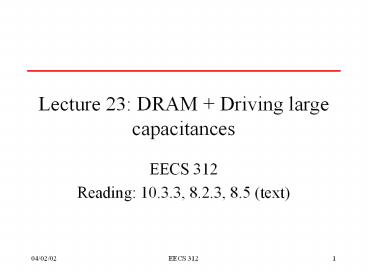Lecture 23: DRAM Driving large capacitances - PowerPoint PPT Presentation
Title:
Lecture 23: DRAM Driving large capacitances
Description:
Using Cascaded Buffers ... 312. 12. Impact of Cascading Buffers. 04/02/02 ... Driving large loads is best done using cascaded buffers with tapering factor of e ... – PowerPoint PPT presentation
Number of Views:66
Avg rating:3.0/5.0
Title: Lecture 23: DRAM Driving large capacitances
1
Lecture 23 DRAM Driving large capacitances
- EECS 312
- Reading 10.3.3, 8.2.3, 8.5 (text)
2
Lecture Overview
- Midterm 2 review
- Finish discussion of memories
- Chip packaging overview
- Driving large loads
3
Midterm 2
4
Packaging
5
Bonding Techniques
6
Flip-Chip Bonding
7
Package Types
8
Package Parameters
9
Driving Large Capacitances
10
Using Cascaded Buffers
X CL/Cin u tapering factor
This ignores self-loading (junction capacitance
of driving stage) derivation on page 450 of text
11
tp as a function of u and x
12
Impact of Cascading Buffers
13
Output Driver Design
14
How to Design Large Transistors
We dont want a long poly run resistive and
large parasitics Place multiple narrower devices
in parallel (with same gate signal)
15
Tristate Buffers
Useful for signals with multiple drivers 2nd
implementation is better in some cases b/c no
series connected devices in output stage
16
Lecture Summary
- Chips must be put in a package to interface with
other devices - Sending signals off-chip requires a lot of
driving capability - Driving large loads is best done using cascaded
buffers with tapering factor of e































